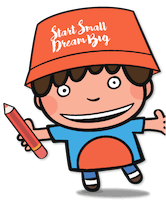“Start small, dream big” is a message with which we wish to impart into every Agape child.
With more advancements in education and technology, protecting the Earth using small gestures can go a long way in keeping the environment healthy and to help it flourish. As more and more people are educated and committed to protect the environment, the children of Agape Little Uni. @ Upper Serangoon has also joined the cause.
To introduce sustainable living in our curriculum, our children have been introduced to positive habits such as using recyclable bags to put their personal belongings, lunch bags and reusable bowls and cutleries. Instead of using plastic bags, we encourage parents to prepare laundry bags to put children’s dirty clothes in, which is more environmentally-friendly.
To continue supporting these good behaviours, we decided to incorporate the 3Rs - reduce, reuse and recycle, into our SSDB project.
We started by deciding what items will be suitable for our SSDB sales. We chose straw bags to encourage parents, teachers, and the community members to use reusable straws, different sizes of canvas bags to place children’s cutleries, bowls and cups, diapers, nap time items and extra clothing. As more and more people are buying drinks outside, we would like to encourage them to use recyclable cup holders instead of plastic ones. We also decided to sell totes bags so that parents could use this opportunity to replace their children’s torn bags or bring it out whenever they go grocery shopping.
Our parents are very proactive and most of them are keen to assist us in this year’s SSDB. There were around 30 parents that volunteered to make the mask lanyard.
Since our parents are involved, our teachers also played our part in this year’s SSDB sale.
For our teacher’s booth, we decided to harvest our vegetables which have been flourishing since last year’s SSDB project – Agape’s Garden. Our cook also uses the vegetable for our daily dishes.
In this year’s SSDB, we included differentiated learning by giving children of different age group to use varying art techniques which is more suitable for their developmental stage.
Infant and Smart Toddler class
Sponge painting is the decorative application of paint onto a surface. This method of painting was used by them Infant and ST children while creating their designs. During the Creation process, children choose their own design and the teachers will help them to paste the design onto the product and children will start to use the sponge and paint.
Nursery 1
Object Printing
All around us, we have objects of different shapes and sizes. The N1 children utilised common daily objects to print and design their products. Items like cookie cutters, cotton buds, spoons and more are just some items which were used! Throughout the creation process, the children were given the autonomy to decide all the variables. From picking their sustainability product, the particular object which they wanted to use to design, to creating flyers for marketing purposes. It was a good opportunity for the children to explore different shapes and colours and also to express their creative thoughts.
Nursery 2
Tie-dye is a resist-dyeing technique that often uses bright, saturated colours and bold patterns. This method was used by the N2 children while creating their designs. During our Production Process, there are lots of ups and downs that we went through. During the N2 tie dye process, the Tie Dye paint is very dull and the colour is very light so we need to change to different Tie Dye paint.
Kindergarten 1
Fabric Drawing
Fabric drawing is the application of specialised paints (fabric markers) to fabric. It is a fun and easy way to create designs on fabric. The K1 children used this method while creating their designs. During the process, teachers will provide recycled paper to draft out their drawing, after they’ve completed it, they start to draw their design onto the product.
Kindergarten 2
Acrylic Painting
Acrylic painting techniques make use of different styles of manipulating and working with polymer-based acrylic paints. This method was used by the K2 children while creating their designs. K2 children enjoyed the process of drafting out their unique designs for the reusable items, poster- making, and flyer making to help spread the word of our “Sustainability Project” and they even helped to slot in the flyers into the letterbox of our neighbourhood.
On the day of the event, the following was the layout of each stall. Altogether we had 6 stalls, which were the children’s booth, parent’s booth, Refreshment booth, Teacher’s booth, DIY booth and also our Cashier.
Children’s booth
There were 3 teachers stationed at the children’s booth. The children’s artwork were displayed and sorted out according to types (cup holders, drawstring bags, tote bags, straw bags etc.) so that it will be easier for parents to admire and identify their children’s artwork.
Parent’s booth
There were 2 Teachers stationed at the parents booth. The teachers displayed the parents creation of the lanyard using some display racks
Refreshment booth
We prepared some light snacks and drinks for parents, children and the community members that participated in our SSDB sale.
Teacher’s booth
There are 2 teachers that were stationed at the teacher’s booth. The teacher’s booths are set up near our garden so that it will be easier for the teachers to harvest the fresh vegetables for the parents.
Do-It-Yourself (DIY) booth
One of our teachers and our centre cook helped out at the DIY booth to assist parents, children and community members in decorating their own bags. We provided them with plain canvas bags, paint and painting
Cashier
There were 2 teachers stationed at the cashier to collect all the donations and also gave out SSDB goodie bags for each purchase and a token of appreciation made by our children. The tokens included paper boxes made out of recycled papers, bookmarks made out of old
cardboard and perfume bags made out of recycled cloth.


























































